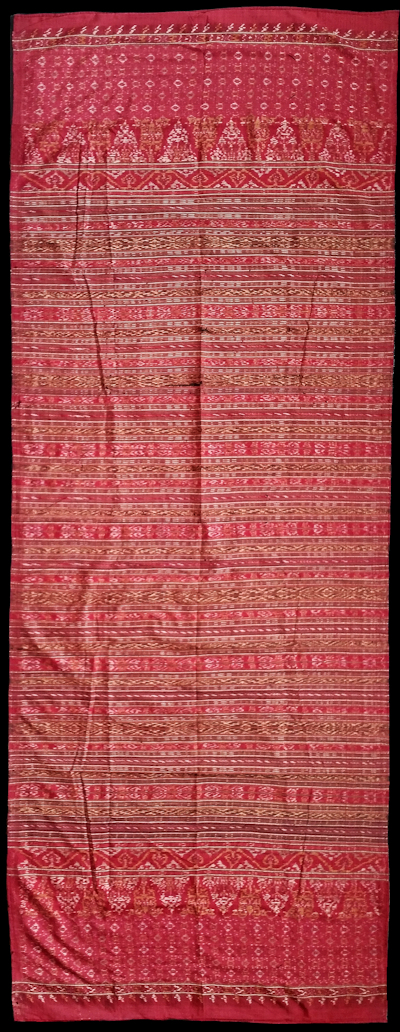| |
 
 | | | |
071 Sumatra, Putih Doh
Kumbut juangga (shawl) 
| | Locale: | Putih Doh in Lampung Province, on Sumatra's southwestern shores, but made elsewhere. | | Period: | mid 18th to mid 19th c. | | Yarn: | Silk, hand-spun, very fine | | Technique: | Weft ikat | | Size: | 77 x 205 cm (2' 6" x 6' 8") LW: 2.66 | | Weight: | 120 g (4.2 oz), 76 g/m2 (0.25 oz/ft2) | | Design: | Numerous narrow bands of ikat in white and yellow on red, alternating with bands in brown and red, separated by narrow accent stripes in plain indigo, gray and white and in supplementary weft, all just one thread wide. Patola-influence is patent, especially in the end panels. A few threads were decorated with the gedog technique: loosely twining threads of different colours to add a shimmering, ikat-like touch - a technique Jasper and Pirngadie found only on Java. (See micro 1.) | | Comment: | [PHOTOGRAPHY PROVISIONAL] This type of shawl, very ostentatious in the refinement of its ikat, and similar to the limar of other parts of Lampung, is called kumbut juangga. Putih Doh did not produce silk ikat but thanks to its port, vital in the pepper trade, was rich enough to get lavish textiles made elsewhere. While some Putih Doh shawls have secondary decoration of the end panels in songket, cloth done purely in ikat appears to be more prevalent, and sets Putih Doh apart from Komering where a more showy finish is favoured. The fragile cloth, which shows several small tears and minute holes, was mounted on a black cotton backing in hand stitching. Curiously, the damage to the fibre is largely limited to the weft, and mostly affects tiny sections of yarn dyed in red, whereas the equally red warp is mostly intact. Possibly the dye used in the weft had additives that over time cost minute damage to the yarn. The weight is an estimate; the weight including the cotton backing is 261 g. The overall impression is sophisticated - diaphanous treasure. | | Background: | Chapters on Sumatra and Putih Doh. | | Sources: | Ikat attributed to Putih Doh is ignored by most authors, either because of the dearth of examples or because it was not made in the region but ordered elsewhere. Even Maxwell's exhaustive Textiles of Southeast Asia does not mention Putih Doh. The museum where Maxwell worked as a curator for many years, the National Gallery of Australia, does have a fine 19th c. example, NGA 2000.87, very similar to ours and in comparable condition, but it is identified as Komering. Another example, probably older, more damaged, and with songket end panels, was collected by Holmgren and Spertus and is now in the Yale University Art Gallery, ILE2006.4.247. Another very similar, mid 17th-18th c. cloth in the Yale collection with the same banded structure but with songket end panels, and in much worse condition, is identified as Komering. On gedog see Jasper and Pirngadie, De Inlandsche Kunst, Deel III, Weefkunst, p. 210. | | |

©Peter ten Hoopen, 2025
All rights reserved.
|
|


